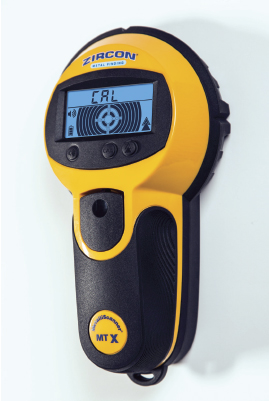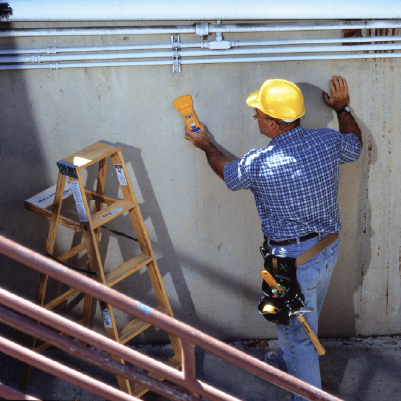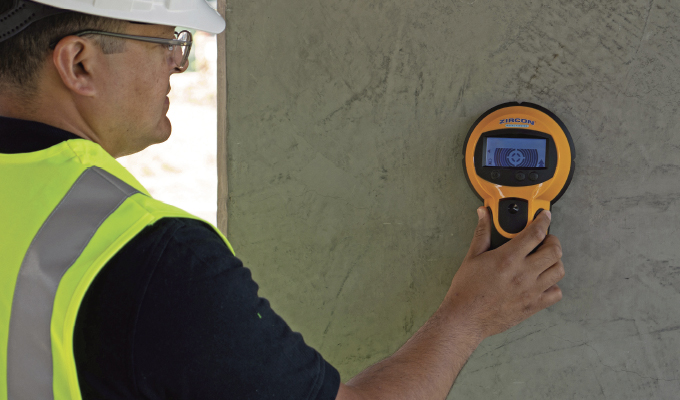Concrete is used virtually everywhere in commercial, residential, and industrial construction. Rebar reinforcement is used to add structural integrity to concrete to keep it from breaking due to fluctuations in tension, compression, temperature, earthquakes, and other stresses.
After a concrete structure has been built, it may be necessary to drill or saw into it to incorporate changes. The trouble is that some construction applications require a significant amount of rebar, which can be set in grid patterns, rows, columns, or even randomly. This creates a situation where it seems impossible to find an appropriate location to drill or cut without hitting metal. Guessing may result in unnecessary holes, equipment damage, and even safety concerns.
To mitigate these risks, construction workers require trustworthy metal-scanning tools.

RISKS OF DRILLING REBAR
A construction site is not a place to take safety risks, but safety is what you risk when you indiscriminately cut or drill into a maze of rebar. When blades or bits hit metal, they can shatter into flying fragments or grab and bind in the material, causing kickback that can result in severe hand and wrist injuries, if not worse. Worker injuries of this nature can lead to project delays and costly workers’ comp claims.
Damaged concrete, drill bits, or saw blades additionally lead to downtime and unnecessary replacement costs.
It is crucial to identify where rebar is located before drilling or cutting into a concrete structure. One technique is ground penetrating radar (GPR), which can locate metallic and non-metallic objects by sending a small electromagnetic pulse into the concrete and analyzing the echoes that result from subsurface objects.
Although GPR is quite effective at locating rebar deep within a concrete structure, the equipment requires extensive training and can be expensive.
BETTER TOOL OPTION
Fortunately, handheld metal detectors have been around for decades and are very easy to use at a lower cost and with fewer headaches than GPR. Zircon, a leading manufacturer of sensor technologies, offers several models that can detect rebar in concrete at different depths, so the end user can select the best device to fit their needs.
Zircon handheld scanning devices include the MetalliScanner MT 7 and the MetalliScanner MT X metal locators.
The MetalliScanner MT 7 metal detector can be used to locate rebar, pipes, and other metal before sawing or drilling. The scanner can locate half-inch rebar up to 6 inches deep. It offers users two scanning modes—Standard and DeepScan modes—with position accuracy to within ± half-inch for No. 4 rebar, which is often used as a strengthening material in slabs, piers, columns, and walls.
The MetalliScanner MT X metal detector is designed to address the difficult task of locating the spaces between rebar in tight grid patterns. In DeepScan mode, the MT X can locate rebar or metal pipes up to 4 inches deep.
DEVIL’S SLIDE PROJECT
A Zircon metal scanner was put to the test during the construction of northbound and southbound tunnels for a project along California’s highly trafficked Highway 1, which runs along the cliffs on the Pacific Coast. The area is known as Devil’s Slide, due to mudslides from the steep terrain above the highway that often close sections of the road for months at a time. The two tunnels are each approximately 4,200 feet long and are connected by ten mechanical rooms.

In one of the first phases of the project, the construction crew was tasked with installing a ventilation system in one of the mechanical rooms. However, due to the extensive amount of rebar, the company’s MetalliScanner MT 6 metal detector (the precursor to its new MT 7) was indicating metal “everywhere.” The tunnel’s construction in earthquake country had required an extraordinary amount of rebar. One observer described the Devil’s Slide Tunnel as, “less like concrete with steel reinforcement and more like a steel wall with concrete filler.”
Given the challenge, the crew contacted a Zircon representative, who visited the jobsite to help troubleshoot the problem. He suggested that instead of focusing the MT 6 on finding metal, the crew should instead focus on the weakest signals to find the gaps in the rebar.
The team used the Zircon MT 6 to scan the remaining nine mechanical rooms in this manner and avoided hitting rebar when drilling 99 percent of the time—a vast improvement.
The next phase of the project involved installing Jet Fans, which required the crew to drill into concrete while suspended high in a bucket. The lightweight MT 6 allowed for quick overhead scans to determine the ideal locations for the 4.5-in. concrete fasteners.
At the project’s completion, the crew advised Zircon that it would be beneficial to add a wrist strap to future metallic scanners to facilitate overhead scanning. This feature has been incorporated in the company’s current model, the MT 7, along with a pivot handle attachment and optional extension pole.
CLOSING THOUGHT
It is crucial to understand where rebar is located before attempting to cut or drill. Handheld rebar detection tools are the easiest and most cost-effective way to avoid the maze of rebar in an existing structure before a drill or saw ever touches the concrete.
For More Information:
For more about Zircon and its wide range of products, visit www.zircon.com.
Modern Contractor Solutions, February 2024
Did you enjoy this article?
Subscribe to the FREE Digital Edition of Modern Contractor Solutions magazine.



